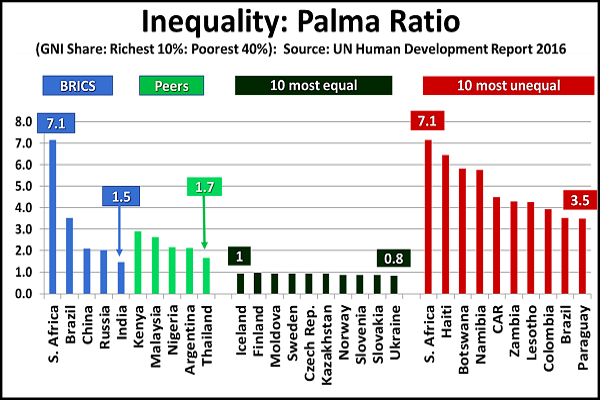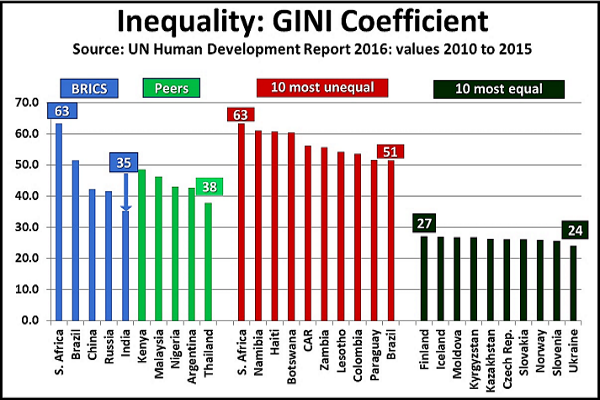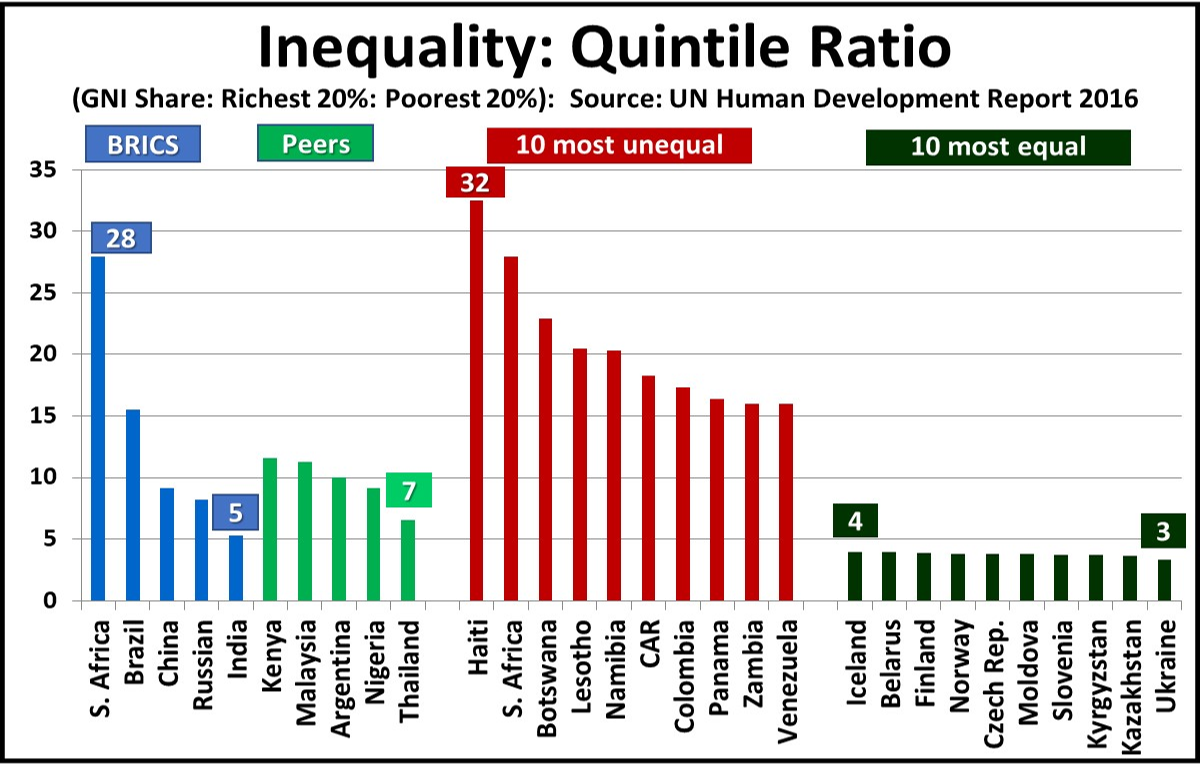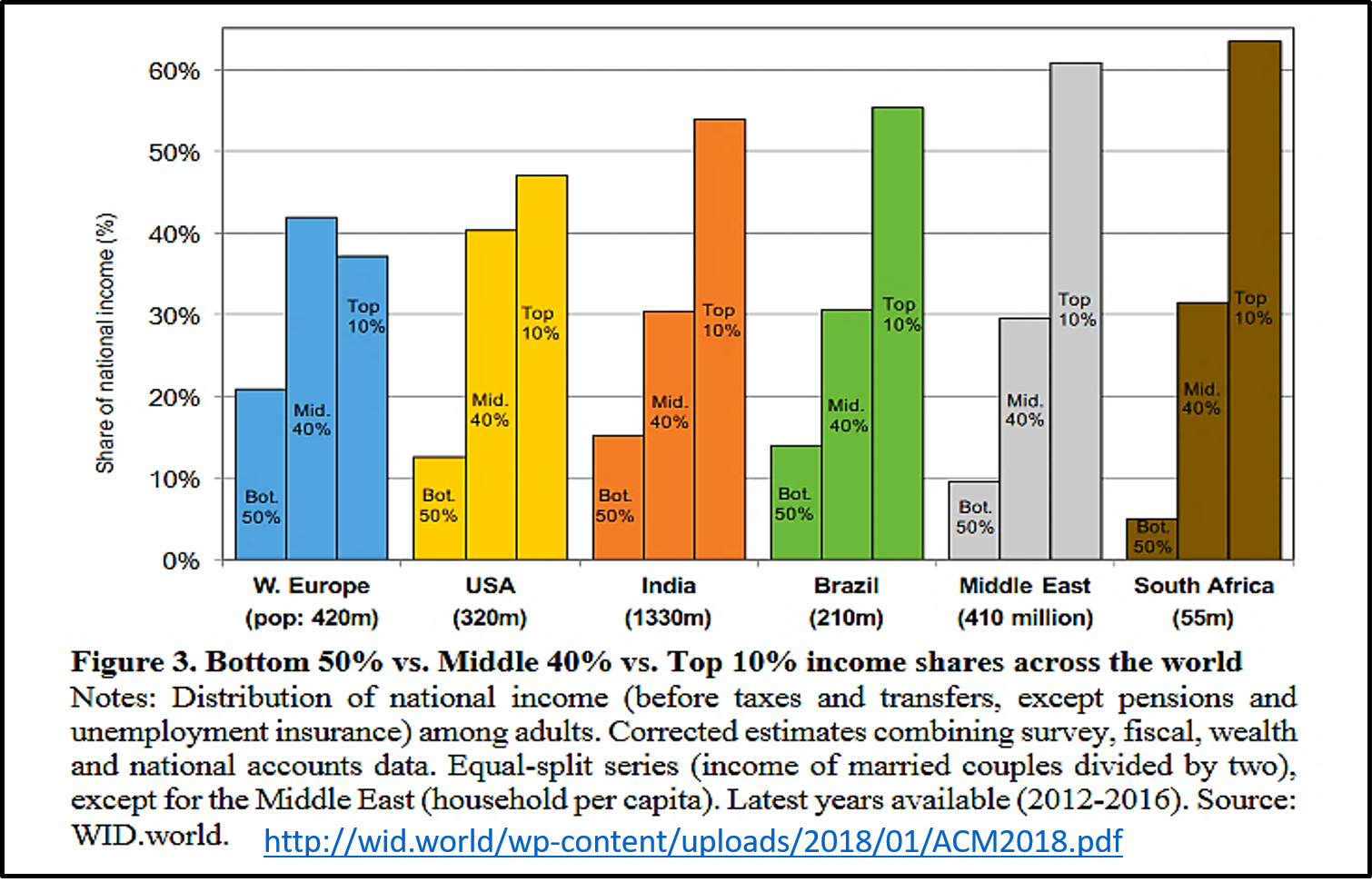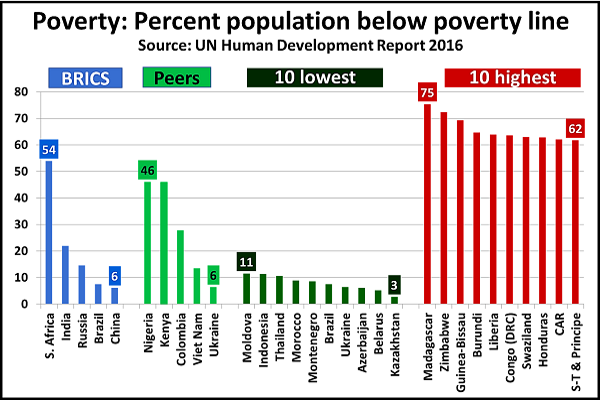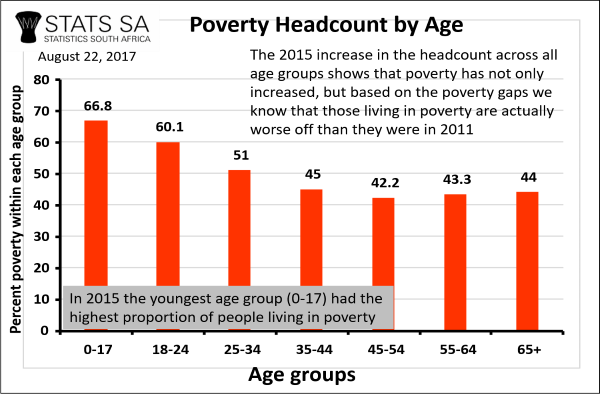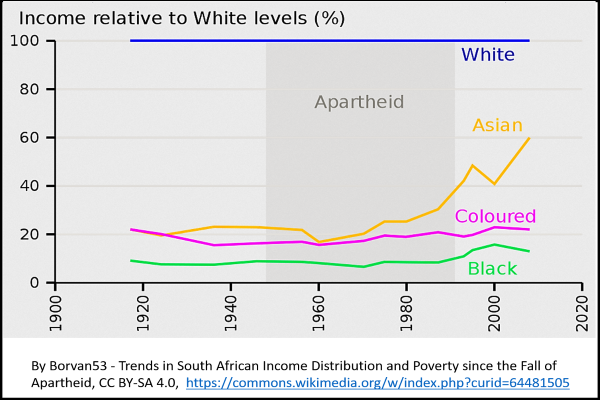Inequality, Poverty, and Unemployment in South Africa
This page provides a close examination of South Africa's triple threats of inequality, poverty and unemployment in more detail than can be provided in the cover page. The South African statistics are benchmarked against the country's peers - the BRICS community, five peer group countries selected for regional representation and other similarities with South Africa, the ten most equal nations, and the ten most unequal nations in 2016. The implications and consequences of South Africa’s extremely high levels of inequality, poverty and unemployment are a cause for great national concern, fully and acknowledged by all arms of government, civil society, and much of the business community. High levels of income inequality have been recognized throughout history as one of the major causes of socio-political instability: “There should exist among the citizens neither extreme poverty nor again excessive wealth, for both are productive of great evil” (Plato, circa 400BC). This presentation of South Africa’s alarming inequality statistics, and the resulting high levels of poverty and unemployment, provides a tool for positioning the national ICT sector as one of many ways of mitigating this dangerous national deficiency. The details of how ICTs can help are the subject of all other pages in this SAKAN website. The quantitative data provided in these SAKAN pages, and the links to the original articles, serves to promote the urgency for direct action, and to provide a framework for measuring and monitoring progress in the virtual cycle implementation mode proposed by SAKAN.
South African Inequality Four inequality measures benchmarking South Africa against other countries, and published globally.
Inequality: South Africa's global leadership in income inequality has a deleterious effect on virtually all aspects of national development. Civil unrest, labour disputes, rising crime levels, and the negative impact on economic growth, are just some of the factors that discourage inward foreign investment that could fuel national economic growth through job creation and the reduction of the poverty burden on the national economy. While numerous national political and business leaders acknowledge the extreme levels of inequality, a central theme of the National Development Plan, there remains a significant amount of skepticism; too many high level decision-makers reject the statistical evidence and underestimate the seriousness of the nation's inequality. A broad-based national consciousness of the seriousness of threat of inequality is a necessary prerequisite for the development of effective responses. This SAKAN initiative is designed to develop that national consciousness, and to develop responsive strategies in its area of competence - the ICT industry.
South African Poverty: Poverty erodes human dignity, identity, self esteem, and therefore social stability. Extreme poverty damages the cognitive development of children, threatening the nation's future. This section provides a closer statistical view of the levels and impact of South Africa's poverty levels.
South African Poverty: With 66.8% of South Africa's children aged 0 to 17 living in poverty, AND a 4IR world which will most likely decimate low-skilled jobs, South Africa needs to act now to hasten the reduction of child poverty, and create a future 4IR-ready workforce. A further highly provocative feature of South Africa's inequality and poverty is the race differential. The last chart in this poverty section provides a proxy for poverty differentials by race. The provocative racial differentials need to be addressed with the utmost sensitivity and visibility. There are no quick fixes for this challenge, however, the absence of visible and well publicized progress is likely to lead to racial tension and/or destructive racial confrontation. Vulnerable populations are often willing to accept lengthy corrective processes, provided these corrective processes and their interim results are transparent, visible, and participatory in nature. SAKAN offers a solution for the vital mass communications needed, and the full and highly visible participation of the vulnerable population groups.
Unemployment: High levels of unemployment, a direct result of inequality of opportunity across the whole scale of human development, eats away at the soul of a nation. All nations in all regions have, as part of their growth philosophies, programmes for employment creation. The results are variable - failure generally leads to civil disturbances and civil wars in the extreme.One of the root causes of the so-called "Arab Spring" that led to the current Middle-East chaos stemmed directly from the frustration of joblessness. The impact of joblessness on the growth of children, in which parents are unable to educate and nurture their children, is a sure recipe for future societal disasters. This section examines the phenomenon closely in an effort to develop the most effective and proactive interventions.
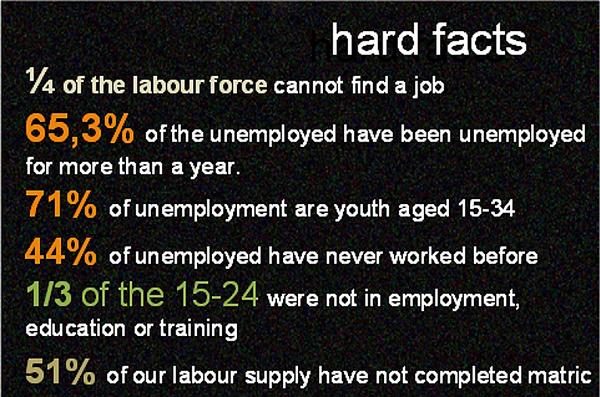 This report by Statistics South Africa (STATS SA) summarizes the situation in 2013. Since then, the unemployment rate has risen steadily from a high of 25.3% in July 2013 to 27.7% in July 2017. In its 2013 “World of Work: publication, STATS SA explains the data as follows: "The unemployment rate based on the official definition was 25,2%. This key labour market indicator measures the people who are unemployed, looking for work, and available for work as a percentage of the labour force – where the labour force includes both the unemployed and those already in employment. Based on the expanded definition – which only requires unemployed persons to be available for work – the unemployment rate was 36,7%" The impact of unemployment on the nation’s youth is of particular concern as discussed in the adjoining paragraph.
This report by Statistics South Africa (STATS SA) summarizes the situation in 2013. Since then, the unemployment rate has risen steadily from a high of 25.3% in July 2013 to 27.7% in July 2017. In its 2013 “World of Work: publication, STATS SA explains the data as follows: "The unemployment rate based on the official definition was 25,2%. This key labour market indicator measures the people who are unemployed, looking for work, and available for work as a percentage of the labour force – where the labour force includes both the unemployed and those already in employment. Based on the expanded definition – which only requires unemployed persons to be available for work – the unemployment rate was 36,7%" The impact of unemployment on the nation’s youth is of particular concern as discussed in the adjoining paragraph.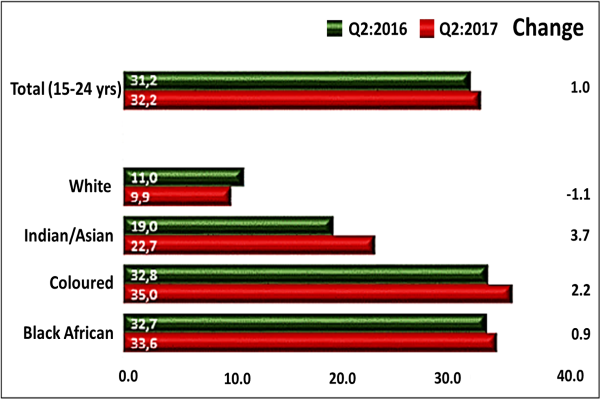 The adjoining chart, published by STATS SA in its Quarterly Labour Force Survey for the second quarter of 2017, adds an even more troubling unemployment factor – the impact of race. The racial divisions of young South Africans who are not in employment, education or training (NEET), is a major national provocation, whatever the historical causes for this alarming state of affairs may be. Racial tensions amongst the nation’s youth is highly visible in the numerous student protests that dominate modern South Africa. These tensions are closely aligned to the racial divisions that underlie South Africa’s massive inequality and poverty levels, and must be addressed before they get out of hand. This SAKAN initiatives suggests a start for this immensely difficult process by focusing exclusively on poor children and youth, 81% of whom fall within the racial classification of “Black Africans”.
The adjoining chart, published by STATS SA in its Quarterly Labour Force Survey for the second quarter of 2017, adds an even more troubling unemployment factor – the impact of race. The racial divisions of young South Africans who are not in employment, education or training (NEET), is a major national provocation, whatever the historical causes for this alarming state of affairs may be. Racial tensions amongst the nation’s youth is highly visible in the numerous student protests that dominate modern South Africa. These tensions are closely aligned to the racial divisions that underlie South Africa’s massive inequality and poverty levels, and must be addressed before they get out of hand. This SAKAN initiatives suggests a start for this immensely difficult process by focusing exclusively on poor children and youth, 81% of whom fall within the racial classification of “Black Africans”.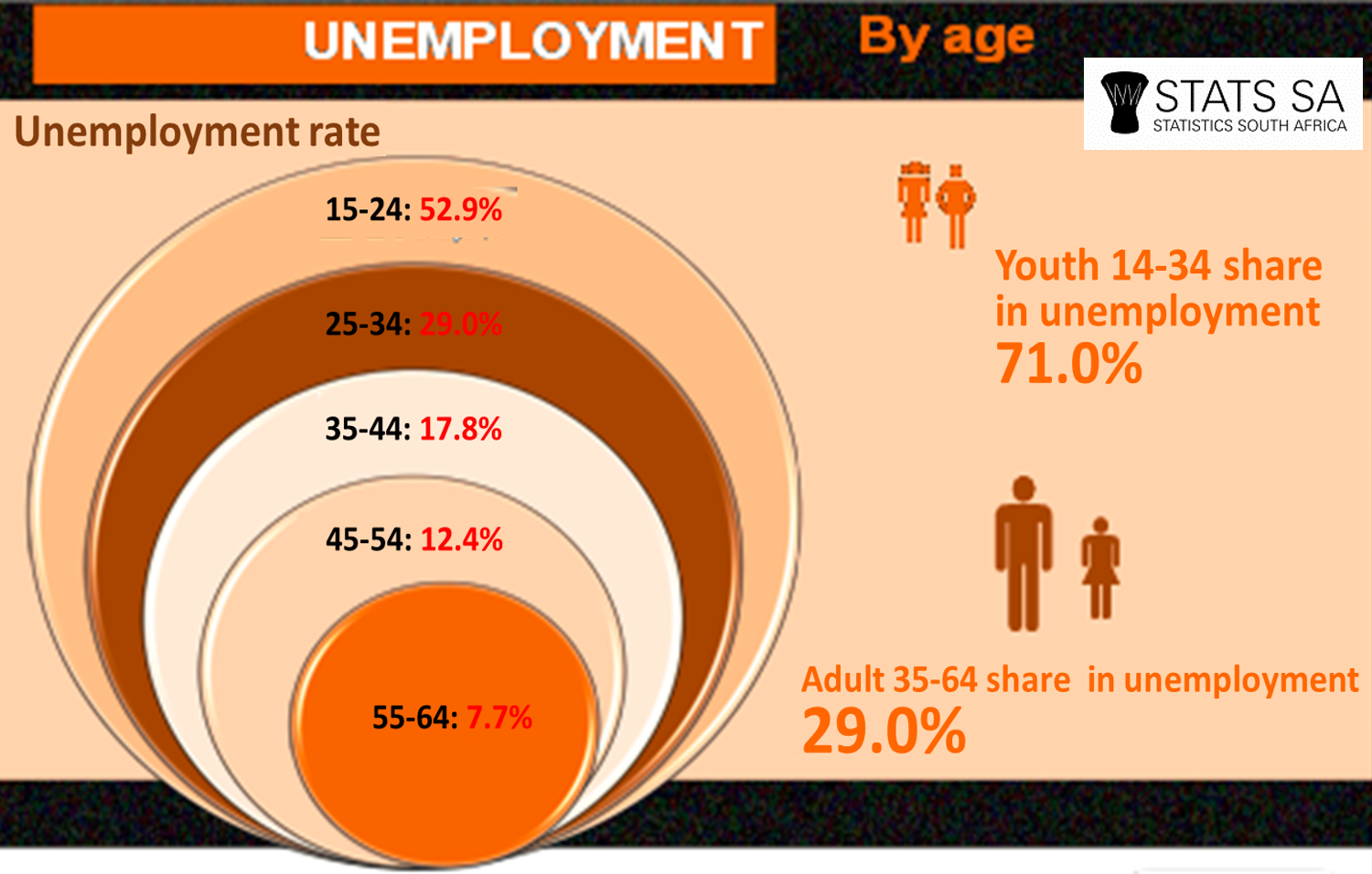 This STATS SA info-graphic provides an excellent illustration of the disturbing levels of youth unemployment. Stemming from a 2013 publication, it may be dated, however, more recent evidence is that youth unemployment levels have increased significantly since then. Given the importance of this metric, in terms of South Africa's future prosperity and survival in the 4IR, it is useful to recall STATS SA's statements supporting this analysis: The social consequences of exclusion faced by people who are not in employment and not in education or training (NEET) have been globally acknowledged with the introduction of a new indicator to monitor their situation. In this regard, young people are particularly vulnerable. In South Africa, for 3,5 million youth aged 15-24 years who were not employed and not in education/training the situation continues to be particularly bleak. Among these young people over 30% of both Black/Africans and Coloureds are NEET, while less than 18% of either Indians or whites fall into that group (Figure 3). Gender differences are also evident. Whereas among male youth, 30% are NEET, among female youth a higher percentage (37%) face the risk of social exclusion.
This STATS SA info-graphic provides an excellent illustration of the disturbing levels of youth unemployment. Stemming from a 2013 publication, it may be dated, however, more recent evidence is that youth unemployment levels have increased significantly since then. Given the importance of this metric, in terms of South Africa's future prosperity and survival in the 4IR, it is useful to recall STATS SA's statements supporting this analysis: The social consequences of exclusion faced by people who are not in employment and not in education or training (NEET) have been globally acknowledged with the introduction of a new indicator to monitor their situation. In this regard, young people are particularly vulnerable. In South Africa, for 3,5 million youth aged 15-24 years who were not employed and not in education/training the situation continues to be particularly bleak. Among these young people over 30% of both Black/Africans and Coloureds are NEET, while less than 18% of either Indians or whites fall into that group (Figure 3). Gender differences are also evident. Whereas among male youth, 30% are NEET, among female youth a higher percentage (37%) face the risk of social exclusion.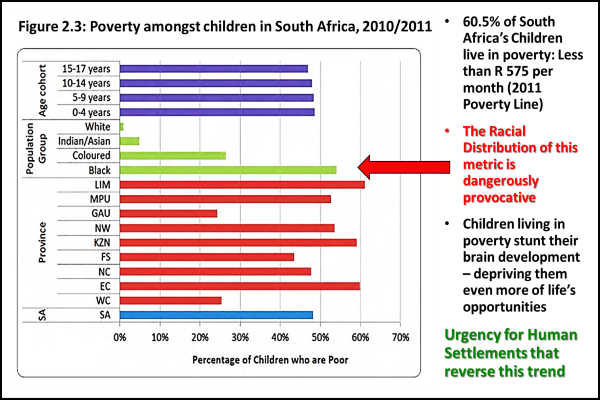 POVERTY TRAPS AND SOCIAL EXCLUSION AMONG CHILDREN IN SOUTH AFRICA 2014: This study commissioned and funded by the South African Human Rights Commission(SAHRC) and the United Nations Children's Fund (UNICEF) begins with the Forward by Lindiwe Mokate, the Commissioner for Children and Basic Education Rights: Poverty, inequality and exclusion are hallmarks of a highly iniquitous society. In order for the rights of all children to be realized, it is essential that this gap- and the resultant chasms in service delivery and overall quality of life- be removed. The child population is one of the segments of the population more prone to becoming trapped in poverty and therefore the most logical site for successful poverty-ending intervention. The publication seeks to explore the kind of intervention that would be necessary to bring this about through literature reviews and policy simulations. The challenge for South Africa goes far beyond the moral sensitivities and value perceptions of the rights of children: child poverty is a guarantee of low socioeconomic growth and potential societal decay, especially in this 4IR knowledge-driven society. SAKAN seeks direct interventions that go beyond policy formulation and support.
POVERTY TRAPS AND SOCIAL EXCLUSION AMONG CHILDREN IN SOUTH AFRICA 2014: This study commissioned and funded by the South African Human Rights Commission(SAHRC) and the United Nations Children's Fund (UNICEF) begins with the Forward by Lindiwe Mokate, the Commissioner for Children and Basic Education Rights: Poverty, inequality and exclusion are hallmarks of a highly iniquitous society. In order for the rights of all children to be realized, it is essential that this gap- and the resultant chasms in service delivery and overall quality of life- be removed. The child population is one of the segments of the population more prone to becoming trapped in poverty and therefore the most logical site for successful poverty-ending intervention. The publication seeks to explore the kind of intervention that would be necessary to bring this about through literature reviews and policy simulations. The challenge for South Africa goes far beyond the moral sensitivities and value perceptions of the rights of children: child poverty is a guarantee of low socioeconomic growth and potential societal decay, especially in this 4IR knowledge-driven society. SAKAN seeks direct interventions that go beyond policy formulation and support. Final Observations on South Africa's "Racial Challenges": The concept of “Race” cannot be biologically defined, especially after the complete sequencing of the human genome in circa 2000 added to the vast volumes of empirical knowledge that began with Charles Darwin and others before him. Race differentials amongst humans cannot be explained scientifically, but racism exists everywhere, especially in modern day South Africa, and its destructive spectre seems to be on the rise again in the modern world. Only knowledge for all about the role of “race” in human development can halt and reverse the alarming race-based disparities shown in some of the charts above. One source of such knowledge stems from the work of one of the world’s most eminent Anthropologist – the South African Scientist Phillip Valentine Tobias (1925 to 2012) – please view his lecture on race here (warning – contains nudity!). The SAKAN concept provides a vital channel to spread this knowledge across all societies and age groups in South Africa and abroad. "Race" must be eliminated totally as a barrier to South Africa’s development.
Final Observations on South Africa's "Racial Challenges": The concept of “Race” cannot be biologically defined, especially after the complete sequencing of the human genome in circa 2000 added to the vast volumes of empirical knowledge that began with Charles Darwin and others before him. Race differentials amongst humans cannot be explained scientifically, but racism exists everywhere, especially in modern day South Africa, and its destructive spectre seems to be on the rise again in the modern world. Only knowledge for all about the role of “race” in human development can halt and reverse the alarming race-based disparities shown in some of the charts above. One source of such knowledge stems from the work of one of the world’s most eminent Anthropologist – the South African Scientist Phillip Valentine Tobias (1925 to 2012) – please view his lecture on race here (warning – contains nudity!). The SAKAN concept provides a vital channel to spread this knowledge across all societies and age groups in South Africa and abroad. "Race" must be eliminated totally as a barrier to South Africa’s development.Concluding Reminder: The scope and consequences of South Africa's Triple Threats
